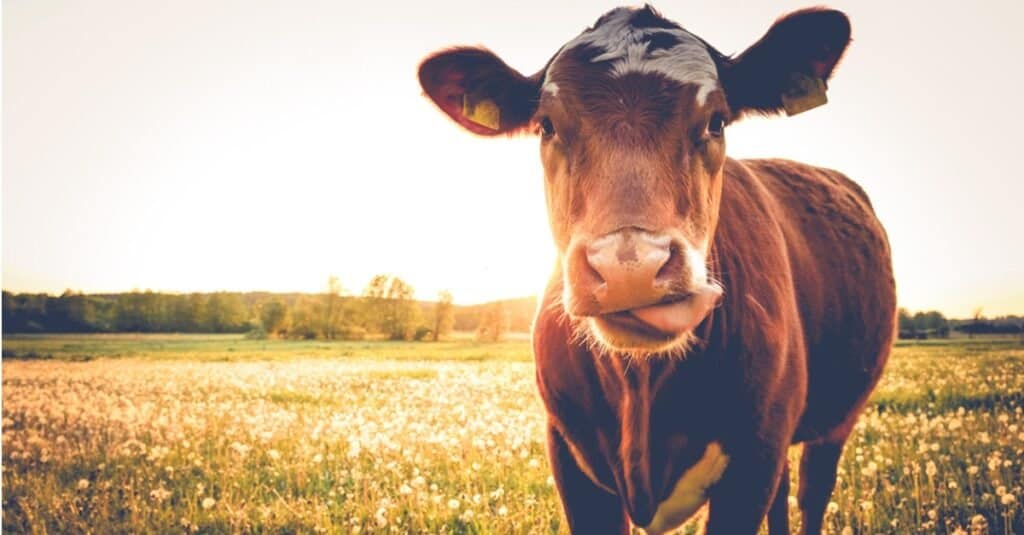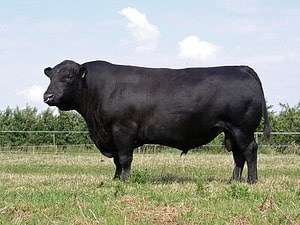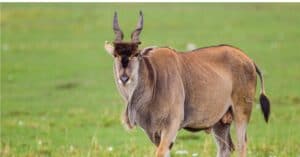Cows are ruminants, that is, they spend much of their time grazing and chewing the cud. But is all that chewing enough to break down the grass they eat? It turns out it isn’t, and these bovids rely on a long process to further break down the food they’ve chewed. As a matter of fact, these herbivores need a specially modified digestive system to process all that food efficiently. How many stomachs do cows have? Read on to learn more about how many stomachs a cow has and why.
The parts of a cow’s stomach
Quite often the response to the question “How many stomachs do cows have?”, results in the answer: four stomachs. In reality, cows have a multi-compartment stomach, which is very different from that of humans. When they take in the grass, it goes through the rumen, then the reticulum, the omasum, and finally the abomasum. Let’s take a look at the functions of the cow’s stomach compartments in more detail.
The first part of a cow’s stomach is the rumen. The rumen has a lot of bacteria in it, and it acts to hold food while the bacteria break down the cellulose, or fiber, in the plants the cow has eaten. Only bacteria can break down cellulose, doing so through the fermentation process — similar to how yeast works. At this point, the food isn’t digested yet and is only partly broken down.
Unlike the human stomach, you won’t find any stomach acid here. If you watch a cow grazing, you’ll notice it taking in a lot of grass, hay, or other plant matter. It doesn’t chew the food like a horse does, but instead chews it just enough to moisten it and then swallows it whole. The food first goes into the rumen until it’s filled up. Because of the bacterial activity going on, the rumen is very warm and the sides feel soft.
Following the rumen is the reticulum. It’s where the food goes into after the rumen, and it allows the cow to regurgitate the food and start doing what’s called “chewing the cud” to break down the food into smaller pieces. The reticulum has bacteria in it, too. With the cow weighing an average of 1,400 pounds, it spends six to eight hours a day eating, and then another five to eight hours chewing cud.
After the reticulum is the omasum. When the cow has finished chewing its cud, it swallows the food again, where it travels on to the omasum. It absorbs water and some nutrients which were already broken down. Appearance-wise, it has several thin folds of tissue which make it feel hard.
Finally, there’s the abomasum, which is where the food is actually digested. The abomasum is considered to be the “true” stomach for all ruminant animals, akin to the human stomach, unlike the foregut which is where fermentation takes place. It has bile and stomach acid in it, but it may also have some bacteria that the rumen used to break down from the cellulose, and it is likewise digested. Any leftover food passes into the intestines.
There are other differences between horse and cow digestion, too. If you look at horse and cow manure, the horse manure still has pieces of grain or grass in it. There are none in the cow manure because the plant matter has been much more broken down and digested.

©SehrguteFotos/Shutterstock.com
Why do cows have so many stomach parts?
The diet of a cow is herbivorous, that is, it relies on plant matter. You could say its stomach is specialized to be able to fully digest the plant matter. Consider the digestive system of a ruminant herbivore such as a cow to a horse, which is a non-ruminant herbivore.
The four compartments of a cows stomach are called the rumen, reticulum, omasum, and the abomasum. These grasses and other plants that cows eat are typically difficult to break down. That is why cows evolved with special stomachs that help them digest these rough foods.
Ruminant herbivores include goats, sheep, bison, buffalo, deer, gazelles, antelopes, and giraffes. All ruminant herbivores have multi-compartmented stomachs with the same four parts. And unlike many other mammals, it has a longer small intestine to further absorb nutrients. Omnivorous and carnivorous animals have smaller small intestines, which are suited for the inclusion and digestion of meat in their diet.
The importance of digestive health for cows
Cows must chew cud for better health and milk production. But to do so, it needs to be relaxed and comfortable, usually while lying down. This activity encourages saliva to control the acidity level of the bacteria.
Not only is it important for farmers to be able to observe the cows chewing cud, but they must feed the cows a proper diet with enough fiber and low moisture, carbohydrates, and acidity. The right level of bacterial acidity in the foregut allows the bacteria to grow and function well in the rumen. Too low an acidity level and the bacterial growth will slow down and the cow won’t be able to digest roughage and absorb the nutrients it normally would from chewing cud. Lactic acid builds up and the cow’s immune system weakens.
Also, harmful bacteria grow and can suddenly kill the cow. Too high an acidity level and the rumen will experience erosion. If ulcers develop, bacteria can enter the bloodstream and infect the liver, causing abscesses. As you can tell, digestive issues are far more serious and fast-acting in cows and other ruminators than in humans and other mammals.
It is a common saying that cows have multiple stomachs, but not how many or why. The reality is that they have multi-compartmented stomachs divided into four parts, including a foregut and a “true stomach.” Each part serves a different function for digesting the grass and other plant matter they chew. Such is a major feature of ruminators.
Next Up…
- Cow Teeth: Do Cows Have Upper Teeth? – Cows have been domesticated for over 10,000 years! Find out what evolution looks like in cow teeth!
- Cow Gestation Period: How Long are Cows Pregnant? – How long are cows pregnant for? Do they give live birth? Keep reading to learn more!
- Cow Lifespan: How Long Do Cows Live? – Can cows live a long time? What is their normal lifespan? Click here to find out!
The photo featured at the top of this post is © Flying broccoli/Shutterstock.com
Thank you for reading! Have some feedback for us? Contact the AZ Animals editorial team.






